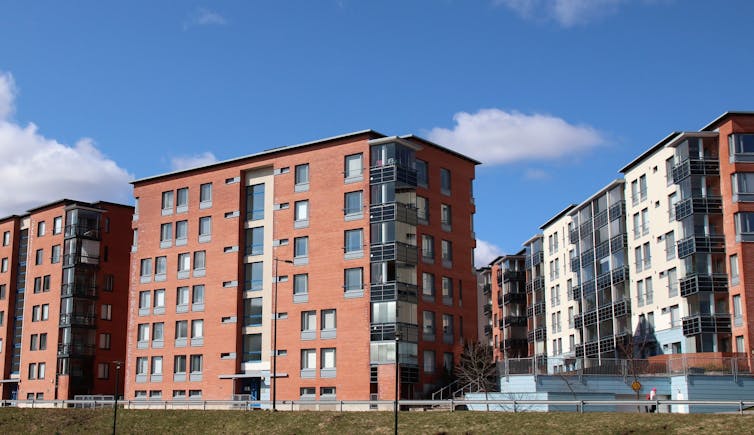Politicians of all stripes say that housing affordability is a top priority. But few are saying much about social housing — the kind that’s needed for low-income households in greatest need of affordable rental housing.
Social housing is non-market housing, either publicly owned or non-profit, and substantially subsidized to ensure low-income renter households pay no more than 30 per cent of their gross income on rent. Canada was committed to this kind of housing after the Great Depression, but began to step away from it in the early 1990s.
With funding from the Social Sciences and Humanities Research Council (SSHRC), the Social Housing and Human Rights coalition is bringing together researchers, advocates and people across Canada experiencing homelessness and housing precarity to raise public awareness about the causes and solutions to the lack of housing for low-income renters.
Failed private sector experiment
I am a researcher and member of the coalition organizing committee. We have synthesized research that tells the story of a 30-plus year experiment, aligned with the rise of neoliberalism, to rely on the private sector to respond to all housing needs.
It hasn’t worked.
Our examination of housing policy in liberal democracies including Canada, the United States, the United Kingdom, Australia and throughout Europe leads us to conclude, as does the Organisation for Economic Co-operation and Development (OECD), that “social housing is a key part of past and future housing policy.”
We conclude that if we are to begin to make progress on an increasingly daunting challenge, the government of Canada will need to do two things:
Create a minimum of 50,000 new rent-geared-to-income social housing units each year for 10 years, starting now. These units should be targeted for the lowest income renter households and those experiencing homelessness, and should have rents permanently set at no more than 30 per cent of household income.
Invest now in the acquisition, construction, operation and maintenance of new and existing public, non-profit and co-operative-owned housing that meets the unique and varied requirements of low-income renters and people experiencing homelessness.
Just scratching the surface
We recognize that adding 50,000 additional units annually is not nearly enough. Instead, we recommend this as a minimum, based on the Canada Mortgage and Housing Corporation’s (CMHC) projected need to expand overall supply by building 5.8 million homes over the next decade.
We estimate that because 33.5 per cent of households are renters, 194,300 of this supply should be rental. Since the CMHC has found that approximately a quarter of renters are paying more than 30 per cent of income on rent, living in housing in poor repair or living in crowded conditions, we believe a minimum of 48,575 (rounded up to 50,000) of new rental housing should be at rent-geared-to-income rates affordable to low-income renters.
This more than triples the target in the federal government’s National Housing Strategy and redirects the focus from modest affordability to deeply affordable. This amount is relatively consistent with calls to double the number of social housing units to more closely align with the OECD average.
New social housing supply requires capital investments for construction so that new housing can be built, and for acquisition so existing properties can be purchased and repurposed or renovated as needed.
New and existing social housing supply also requires investments in ongoing subsidies to support the costs of operating the housing while charging rent-geared-to-income rents. It will require ongoing capital investments for the purpose of maintaining the quality of housing and preserving the stock. Operating costs may include services and programs that support tenants.
Calls for change ignored
Social Housing and Human Rights coalition members are now reaching out to MPs across the country to make the case that more social housing is needed. It’s a challenge.
Despite the evidence, some are quick to tell us they don’t believe social housing is needed and that governments should simply incentivize private sector developers and remove “red tape.”
But our research shows no evidence this will work.
Private-sector solutions were the focus of cost-shared federal/provincial/territorial initiatives beginning in 2001 through the Affordable Housing Framework Agreement. But the emphasis on limited capital grants per unit resulted in modest development of units renting at 80 per cent of average market rents, unaffordable to low-income households. Furthermore, agreements requiring rents be set at affordable rates for 15 years have now expired.
The shortage of truly affordable rental housing across Canada has only worsened because governments have not been willing to invest in social housing. Yes, it is expensive — at least in the short term — and it is getting more expensive each year. But as demonstrated by Finland, a country that has remained committed to social housing investment, it pays off in the long term.

Lessons from Finland
The Finns have tackled homelessness like no other country. They know that without public investment in safe, stable housing, people are at higher risk of having poor mental and physical health, poor education outcomes, weaker labour market attachment and a host of other issues that governments must attend to.
There are many strategies needed simultaneously to address housing affordability. The expansion of social housing supply is one.
But calls are all too often ignored by governments turning to the private sector for low-cost quick fixes that continue to fail those in greatest need.![]()
Shauna MacKinnon, Professor and Chair, Department of Urban and Inner-City Studies, University of Winnipeg
This article is republished from The Conversation under a Creative Commons license. Read the original article.



